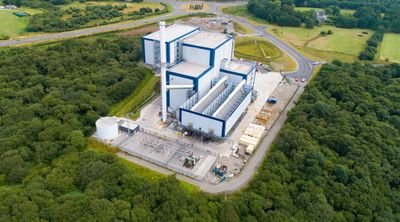Margam Green Energy Plant
| Error: no local variable "site" has been set. Error: no local variable "status" has been set. | |
 See Biomass EfW → page for a larger UK Wide map. | |
| Operator | Error: no local variable "operator" has been set. |
| Capacity | Error: no local variable "capacity" has been set. MWe |
| Feedstock | Error: no local variable "mainfeed" has been set. |
| EPR (Waste Licence) | Error: no local variable "epr" has been set. |
| ROC | Error: no local variable "roc" has been set. |
| CfD | Error: no local variable "cfdcap" has been set. |
| CHP | Error: no local variable "chp" has been set. |
Operators Annual Report
Input Data
| Year | Wood | Litter | RDF | Other | Total |
|---|
Output Data
| Year | IBA | IBA %ge of Tot IN | APC | APC %ge of Tot IN |
|---|

Summary
A Biomass Waste EFW located near Port Talbot, South Wales, generating c. 40 MW[1] based on an annual combustion rate of c.335,000 tonnes of wood waste per annum[2].
The plant is owned by Glennmont Partners, a specialist clean energy investment fund which focuses on investment in clean energy infrastructure. Originally the Margam project was a joint venture between Cardiff based energy development company, Eco2 Ltd and a local company, Western Logs Group. Eco2 Ltd now has responsibility for the plants overall operations and fuel management supply[1]. The project was one of the final of its type to be supported under the Renewables Obligation [3].
The plant became operational in 2019 at a cost of c.£160m[1].
The Margam plant takes waste wood that is supplied by Stobart Biomass on a long term contract. The waste wood is sourced and supplied by Stobart from across the country at a rate of approximately 6,000 tonnes per week[1]. The plant is also capable of processing contaminated wood and fuel containing metals with no pre-treatment required. The facility is also able to take municipal waste as a fuel source in the future if required[2].
Plant
The main EPC contractor was the consortium of Babcock Wilcox VØlund a/s (BWV) and Interserve Construction Ltd. VØlund is part of the Babcock & Wilcox Group, and provided the process equipment whilst Interserve (Wales) undertook the civil engineering and building. BWV now has responsibility for the plant’s operations and maintenance[1] for the next 15 years[2].
The plant features the patented advanced DynaGrate® technology which can handle all types of biomass and waste and is based on the Bruun & Sørensen technology.[2].
